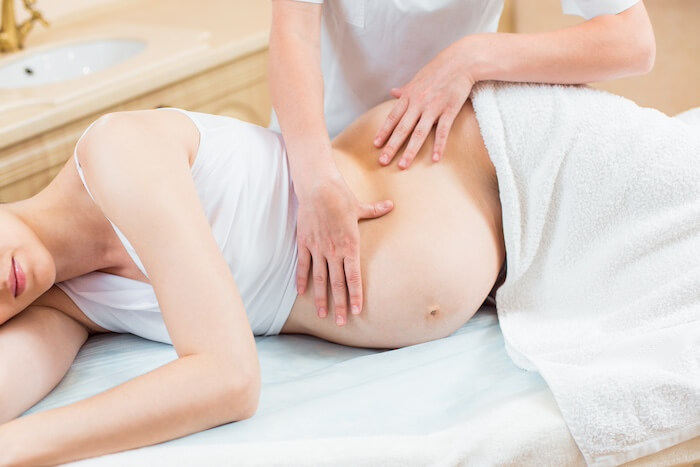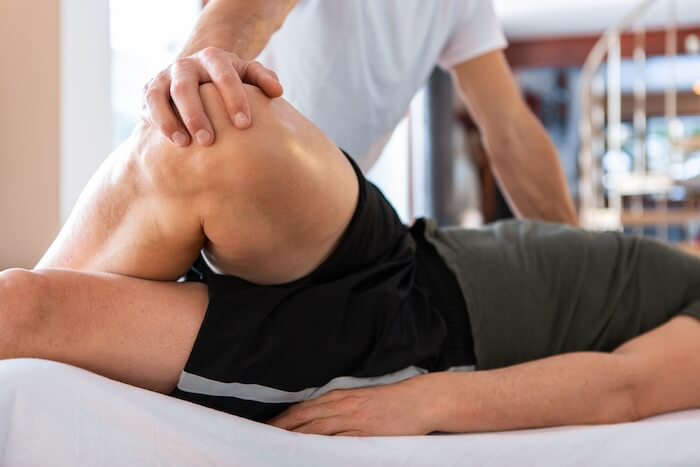How To Choose A Qualified Prenatal Massage Therapist
Selecting a qualified prenatal massage therapist is more than a luxury – it’s a crucial decision that impacts the health and well-being of both mother and baby during pregnancy. This choice hinges on finding a professional adept at navigating the intricate landscape of prenatal care, ensuring both safety and relief from the common discomforts of pregnancy. Through this guide, you’ll learn the importance of certifications, experience, and specialized knowledge in choosing your therapist. Learn how to identify a prenatal massage therapist who not only meets but exceeds your expectations, providing a sanctuary of comfort and care during these transformative months.
What Is A Prenatal Massage Therapist?
A prenatal massage therapist specializes in massage techniques tailored for expectant mothers. They possess a deep understanding of the physiological changes that occur during pregnancy and how to adapt their methods to address these changes safely. Their expertise not only provides relaxation and stress relief but also targets the specific discomforts associated with pregnancy, making them an essential support for maternal health and well-being.
Why Choosing A Qualified Therapist Is Crucial?
Opting for a qualified prenatal massage therapist is vital to ensure the safety of both mother and baby. These professionals are trained to navigate the unique needs of pregnant women, providing targeted relief from the common discomforts of pregnancy. By choosing a therapist with the right qualifications, you’re not just investing in momentary relaxation, but in the overall well-being of your pregnancy journey, making it a crucial step for a healthy and comfortable gestation period.
Ensures Safety For Mother And Baby
Choosing a qualified prenatal massage therapist is crucial for the safety of both mother and baby. These professionals are specifically trained in techniques that prioritize the well-being of the pregnancy, effectively minimizing any potential risks. This careful selection ensures a secure and nurturing environment for prenatal care.
Provides Targeted Relief From Pregnancy Discomfort
A qualified therapist excels in offering targeted relief from the various discomforts associated with pregnancy. Their specialized knowledge enables them to address issues such as back pain, swelling, and stress with precision, making the treatment both effective and soothing. This focused approach significantly enhances the overall pregnancy experience, reducing discomfort and promoting relaxation.
Essential Qualifications For Prenatal Therapists
For a therapist to be deemed qualified in prenatal massage, certification from a recognized body is paramount. This certification confirms they have received specialized training in prenatal care, arming them with the necessary skills to cater to the needs of pregnant women safely and effectively. Furthermore, a deep understanding of the physiological changes during pregnancy is essential. This knowledge enables therapists to adjust their techniques to the unique challenges of each trimester, ensuring the safety and comfort of the expectant mother throughout her pregnancy journey.
Certification From A Recognized Body
Certification serves as a critical benchmark for a prenatal massage therapist’s qualifications. It signifies that the therapist has undergone specialized training from a recognized institution, equipping them with the necessary skills to safely deliver prenatal massage. This certification is a fundamental requirement for therapists aiming to effectively support the health and well-being of pregnant women.
Understanding Of Pregnancy’s Physiological Changes
A deep understanding of the physiological changes during pregnancy is indispensable for a prenatal massage therapist. This knowledge enables them to adapt their massage techniques to meet the evolving needs of each trimester, prioritizing the comfort and safety of the expectant mother. This specialized understanding is what sets a qualified prenatal therapist apart from general massage practitioners.
By ensuring a prenatal massage therapist has the right certifications and a deep understanding of pregnancy’s physiological changes, you can trust that they are well-equipped to provide safe and effective care tailored to your needs during this special time.
Finding A Qualified Prenatal Massage Therapist
Locating a qualified prenatal massage therapist involves a strategic approach. Seeking recommendations from healthcare providers is a reliable first step, as they often have connections with trusted professionals in prenatal care. Additionally, utilizing professional massage therapy associations can help you find certified therapists with the necessary training and expertise in prenatal massage. These steps ensure you connect with a therapist who not only has the right qualifications but also understands the unique needs of pregnancy, providing a safe and beneficial experience.
Seek Recommendations From Healthcare Providers
Doctors, midwives, and other prenatal care specialists often maintain a network of certified therapists they endorse. This method ensures you’re guided toward professionals recognized within the medical community for their proficiency in prenatal care.
Utilize Professional Massage Therapy Associations
These associations feature directories of therapists who have fulfilled stringent training and certification standards, simplifying the search for someone with the requisite qualifications and experience in prenatal massage. Leveraging this resource can be crucial in finding a therapist adept at addressing the unique needs of pregnancy.
Key Questions For Potential Therapists
When evaluating a potential prenatal massage therapist, it’s essential to ask the right questions. Inquiring about specific prenatal training ensures they possess the specialized knowledge necessary for pregnancy massage. Asking about experience with high-risk pregnancies reveals their capability to manage more complex situations.
Furthermore, discussing techniques used for pregnancy discomforts allows you to understand their approach to addressing the common challenges of pregnancy. These inquiries are not only pivotal in assessing the therapist’s qualifications but also crucial in building your confidence in their ability to provide safe and effective care tailored specifically to your needs.
Inquire About Specific Prenatal Training
Inquiring about specific prenatal training is essential. This question verifies that the therapist has received the education necessary to comprehend the intricacies of pregnancy. Ensuring they have specialized training confirms their capability to offer safe and effective prenatal massage.
Questions To Ask About Prenatal Training:
- What specific prenatal massage training have you completed?
- Can you tell me about the duration and content of your prenatal massage course?
- How do you stay updated with the latest prenatal massage techniques and research?
Ask About Experience With High-Risk Pregnancies
Asking about experience with high-risk pregnancies provides valuable insight into the therapist’s proficiency in managing delicate situations. A therapist skilled in high-risk conditions is better equipped to modify their techniques to safeguard the well-being of both mother and child.
Understanding High-Risk Pregnancies
High-risk pregnancies may include conditions such as preeclampsia, gestational diabetes, or a history of miscarriages. Specialized experience is crucial because these conditions require careful consideration and adaptation of massage techniques to ensure safety.
Questions To Ask About High-Risk Pregnancy Experience
- Have you worked with clients who had high-risk pregnancies? Can you share how you adapted your approach?
- What specific precautions do you take when providing massage therapy to someone with a high-risk pregnancy?
- How do you collaborate with healthcare providers to ensure a safe massage experience for high-risk pregnancies?
Discuss Techniques Used For Pregnancy Discomfort
Discussing techniques used for pregnancy discomforts is crucial for understanding how the therapist tackles common issues associated with pregnancy, like back pain or edema. This conversation sheds light on the therapist’s method of providing relief and their adaptability in customizing the massage to your specific pregnancy needs.
Questions To Discuss Techniques For Pregnancy Discomforts
- Can you explain how you address common pregnancy discomforts such as back pain, swelling, and sciatic pain?
- Are there specific massage techniques you find most effective for pregnant clients?
- How do you tailor your massage approach to each trimester of pregnancy?
By asking these detailed questions, you can gain a deeper understanding of the therapist’s expertise, experience, and approach to prenatal massage, ensuring they are well-equipped to provide you with the best possible care during your pregnancy.
Considerations For Selecting Your Therapist
When choosing your prenatal massage therapist, several key considerations come into play. Your comfort level with the therapist is paramount, as trust and relaxation are critical components of effective prenatal care. The proximity of the therapist to your home or work can greatly influence the convenience and frequency of your visits. Lastly, an evaluation of therapy costs and insurance compatibility is essential to ensure the sessions are financially sustainable. Taking these factors into account can significantly enhance your prenatal massage experience, making it both beneficial and enjoyable.
Personal Comfort Level With The Therapist
Feeling relaxed and trusting towards your therapist enhances the effectiveness and enjoyment of the prenatal massage. It’s vital to select a therapist with whom you resonate, creating a nurturing and supportive environment for your care.
Evaluating The Therapy Environment
Assessing the therapy environment is a crucial step in selecting the right prenatal massage therapist. The cleanliness and safety of the facility are paramount, ensuring a hygienic space that meets health standards. Additionally, the availability of pregnancy-specific equipment, like supportive pillows, significantly enhances comfort during sessions. A well-equipped and safe environment not only aids in the effectiveness of the therapy but also contributes to your overall sense of well-being and relaxation during this special period.
Cleanliness And Safety Of The Facility
A facility that maintains high hygiene standards minimizes health risks while implementing safety measures to provide peace of mind during sessions. Opting for a facility that rigorously adheres to these standards is essential for ensuring a secure environment for prenatal care.
Availability Of Pregnancy-Specific Equipment
Specialized equipment, such as ergonomic tables and pregnancy pillows, is designed to accommodate the unique physical needs of expectant mothers, promoting comfort and safety. Choosing a therapist equipped with such tools is vital for a supportive and effective massage session.
When visiting a potential prenatal massage therapist, observing the availability and use of these specific pieces of equipment can provide insight into the therapist’s preparedness and commitment to providing a safe, comfortable, and effective prenatal massage experience.
After The First Session
Following the initial prenatal massage session, it’s crucial to assess your comfort during the massage and monitor your body’s response post-massage. Reflecting on your level of ease with the therapist and the techniques utilized can help you decide if this professional is the right match for your continued prenatal care. Additionally, noting any physical changes or discomforts in the days following the session can offer insight into the treatment’s effectiveness. This post-session reflection is essential for ensuring that the prenatal massage therapy meets your health and wellness objectives during pregnancy.
Assessing Your Comfort During The Massage
Consider how relaxed and at ease you felt with the therapist’s techniques and communication style. A high level of comfort and trust in your therapist’s approach is vital for a beneficial prenatal massage experience.
Monitoring Your Body’s Response Post-Massage
Observe any changes in discomfort levels or overall physical sensations in the days following the session. This careful monitoring allows you to assess the positive impacts of the massage on your pregnancy-related discomforts and general well-being.
Schedule Your Appointment Today
Choosing a qualified prenatal massage therapist is a vital decision that can profoundly impact your comfort and well-being during pregnancy. A therapist with the right qualifications and experience can provide not only relaxation and relief from pregnancy-related discomforts but also ensure safety for both you and your baby. Remember, your body and needs are unique, especially during this special time. Don’t settle for anything less than a therapist who is skilled, empathetic, and knowledgeable about prenatal care. Take the time to research, ask questions, and find the perfect match for your prenatal journey. Schedule your appointment with a qualified prenatal massage therapist today and embrace a more comfortable and joyful pregnancy experience.




